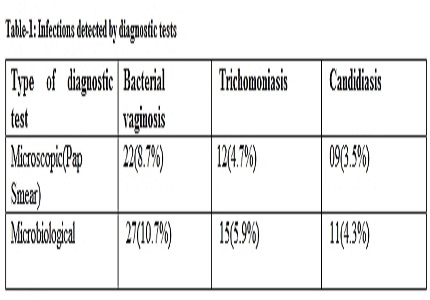Inflammatory PAP smears and its microbiological association: A prospective study
Abstract
Background: Non specific inflammatory PAP smears are common and cause clinical dilemma in management of patient. Microbiological methods are more accurate method of diagnosis of pathogens of female genital tract.
Materials and Methods: A total of 252 PAP smears and vaginal swabs of nonpregnant women referred to the laboratory, constituted the material of the study.
Results: Pap smears showed high predictive values, comparable to microbiological testing in detection of pathogens. Apart from inflammatory pattern, a spectrum of diagnosis was given, based on cytological criteria. Majority of the PAP smears in which pathogens were detected, showed significant inflammation. Bacterial vaginosis constitutes the most common cause of vaginal discharge, followed by Trichomoniasis and then Candidiasis in our set up. Pap smears also revealed that 7 out of 252 cases were having various grades of cervical dysplasia.
Conclusions: A report of inflammatory changes on the cervical Pap smear cannot be used to reliably predict the presence of a genital tract infection. Combination of PAP smear and simple, cost effective microbiological tests, coupled with primary clinical diagnosis lead to significant improvement in patient management.
Downloads
References
2. Thulkar J, Kriplani A, Agarwal N, Vishnubhatla S. Aetiology & risk factors of recurrent vaginitis & its association with various contraceptive methods. Indian J Med Res. 2010 Jan;131:83-7. [PubMed]
3. R. Amsel, P. A. Totten, and C. A. Spiegel. Nonspecific vaginitis: diagnostic criteria and microbial and epidemiologic associations. Am J Med 1983 74(1): 14–22. DOI: http://dx.doi.org/10.1016/0002-9343(83)91137-3.
4. R. P. Nugent, M. A. Krohn, and S. L. Hillier. Reliability of diagnosing bacterial vaginosis is improved by a standardized method of gram stain interpretation. J Clin Microbiol. 1991;29(2):297-301.
5. B. A. Kelly and A. S. Black. The inflammatory cervical smear: a study in general practice. The British Journal of General Practice. Br J Gen Pract 1990; 40(335):238–40.
6. Wilson JD, Robinson AJ, Kinghorn SA, Hicks DA. Implications of inflammatory changes on cervical cytology. BMJ. 1990 Mar 10;300(6725):638-40.
7. Lanouette JM, Puder KS, Berry SM, Bryant DR, Dombrowski MP. Is inflammation on Papanicolaou smear a risk factor for preterm delivery? Fetal Diagn Ther. 1997 Jul-Aug;12(4):244-7.
8. Al-Awadhi R, Al-Ramadan BA, George SS, Sharma PN, Kapila K. Gynecologic infections seen in cervical smears in Kuwait. Acta Cytol. 2010 Jan-Feb;54(1):50-4.
9. Papanicolaou smear: the predictive value for infection in asymptomatic women. Family Medicine 1992;24(6):. 447–52.
10. G. G. G. Donders, A. Vereecken, E. Bosmans, A. Dekeersmaecker, G. Salembier, and B. Spitz. Definition of a type of abnormal vaginal flora that is distinct from bacterial vaginosis: aerobic vaginitis. BJOG 2002;109(1): 34–43.
11. Sania Tanveer Khattak, Imran-ud-din Khattak, Tabassum Naheed and Shehnaz Akhtar Tanveer Jamal. Detection of abnormal cervical cytology by pap smears. GJMS 2006;4(2):74-77.
12. Heller DS, Maslyak S, Skurnick J. Is the presence of Trichomonas on a Pap smear associated with an increased incidence of bacterial vaginosis? J Low Genit Tract Dis. 2006 Jul;10(3):137-9. [PubMed]



 OAI - Open Archives Initiative
OAI - Open Archives Initiative


